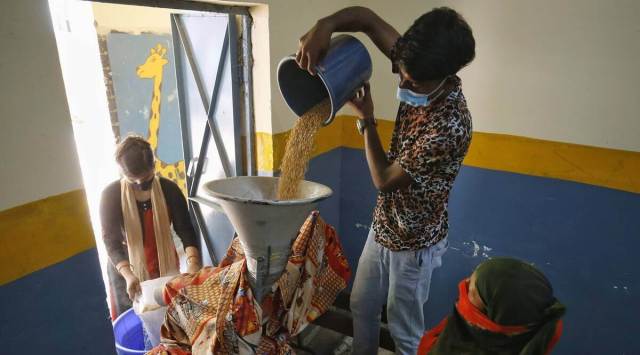IMF working paper: ‘In pandemic, food subsidy kept extreme poverty low’
"Extreme poverty was as low as 0.8 per cent in the pre-pandemic year 2019, and food transfers were instrumental in ensuring that it remained at that low level in the pandemic year 2020," the paper said.
 The Pradhan Mantri Garib Kalyan Anna Yojana was launched in March 2020 and last month, the Union Cabinet extended the scheme till September 2022.
The Pradhan Mantri Garib Kalyan Anna Yojana was launched in March 2020 and last month, the Union Cabinet extended the scheme till September 2022.The safety net of free foodgrains cushioned Covid’s economic shock, providing insurance to the poor and preventing any sharp increase in extreme poverty levels during pandemic year 2020, according to a working paper of the International Monetary Fund.
🗞️ Subscribe Now: Get Express Premium to access the best Election reporting and analysis 🗞️
The paper is authored by Surjit Bhalla, Executive Director, IMF for India, Bangladesh, Bhutan and Sri Lanka and former part-time member of Prime Minister’s Economic Advisory Council; New York-based economist Karan Bhasin; and Arvind Virmani, former Chief Economic Adviser to the Government of India.
“Extreme poverty was as low as 0.8 per cent in the pre-pandemic year 2019, and food transfers were instrumental in ensuring that it remained at that low level in the pandemic year 2020,” the paper said.
Extreme poverty was defined by World Bank as share of people living under $1.9 every day as per 2011 purchasing power parity terms, it said. “The low level of extreme poverty– around 0.8 % in both 2019 (0.76 %) and 2020 (0.86 %) – is suggestive of the need for the official poverty line to now be PPP $3.2,” it added.
The Pradhan Mantri Garib Kalyan Anna Yojana was launched in March 2020 and last month, the Union Cabinet extended the scheme till September 2022.
Under the PMGKAY, the Centre provides 5 kg food grains per month for free. The additional free grain is over and above the normal quota provided under the National Food Security Act (NFSA) at a subsidised rate of Rs 2-3 per kilogram.
The paper flagged the effect of subsidy adjustments on inequality. “Real inequality, as measured by the Gini coefficient, has declined to near its lowest level reached in the last forty years — it was 0.284 in 1993-94 and in 2020-21 it reached 0.292…Possibly the more surprising result from the incorporation of food subsidies into the calculation of poverty is that extreme poverty has stayed below (or equal to) 1 per cent for the last three years.”
Economists caution against using one international poverty line across rural and urban areas where prices diverge.
However, some economists sound a note of caution. “To use that poverty line, what you need is income distribution because $1.9 is income. Officially, we do not produce income distribution data, we have expenditure data. The distribution of income and the distribution of expenditure are never the same,” said Pronab Sen, former Chief Statistician of India said.
Sen added that usually a national poverty line is built using state-level poverty and prices data. “Using an international poverty line has its own problems. The reason being that you have the same metric $1.9 PPP for all parts of the country and both rural and urban. We know in India that if you go statewise, the price difference can be as much as 30 per cent between the high cost states and lower cost states and between rural and urban, it’s even larger.”
The paper noted that the PPP $1.9 poverty line is no longer appropriate for India. “Nevertheless, it is accepted as the extreme poverty line around the world and used as a reference standard for claims about the elimination of extreme poverty. By this standard, India can reasonably claim that in pre-pandemic India was on the verge of eliminating extreme poverty,” it said.
It also said that as early as 2016-17, extreme poverty had reached a low 2 per cent level. “According to the more appropriate but 68 per cent higher Low Middle Income (LMI) poverty line of PPP (purchasing power parity) $3.2 a day, poverty in India registered 14.8 per cent in the pre-pandemic year 2019-20,” the paper noted.
India does not have latest updated consumption expenditure data. The Ministry of Statistics and Programme Implementation had in 2019 cited “data quality issues” and decided against releasing the findings of the Consumer Expenditure Survey results of 2017-18.







